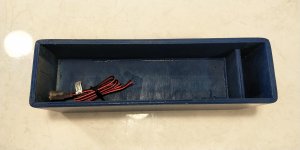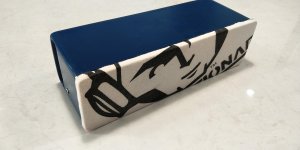Guys, 2xND65's (full range) in a 0.06cuft box, happy with the F3 of 68hz, would one try 4 of 1" pipes (not sure length yet) or a L slot (box internal h 70mm d 90mm L 280mm). I'm trialling 7mm thick ply with 2 layers on the front, so have enough to make a L slot if it is most benefical. When sim'd a 20mm x 70mm wants a length of 350mm and has a 1st port resonance of 484hz, is that too high? I would love it (if going a L slot) to only have a 10mm wide opening?
Any advice would be appreciated as most of my port sizing to date has been heavily assisted and i'm not 100% sure what the 1st port should be.
Any advice would be appreciated as most of my port sizing to date has been heavily assisted and i'm not 100% sure what the 1st port should be.
Not clear on what you are trying to do here. I take it you have a volume of 1.69 litres with 2 drivers per box (not advisable with FR drivers due to combing). By the dimensions it looks like a horizontal soundbar thing.
Can't see an need for a slot port as one 25mm-32mm port would be enough.
If you give more details of the design, some of the FR guys might help as I'm not familiar with the driver.
Can't see an need for a slot port as one 25mm-32mm port would be enough.
If you give more details of the design, some of the FR guys might help as I'm not familiar with the driver.
Sorry it was two drivers in a 0.06 cuft box, just for a battery Bluetooth application. It seemed to model alright in Winisd with a F0 of 75-80 hz.
Look I will say something now, I got impatient and built the box, then put a l slot port in and routed the end (where it comes out). Then stupidly super glued the speakers onto the back of the faceplate thinking it would be easily removed. To be honest it sounds alright but did reduce the box volume by putting in the long port, does sound a bit bright at the high end
Look I will say something now, I got impatient and built the box, then put a l slot port in and routed the end (where it comes out). Then stupidly super glued the speakers onto the back of the faceplate thinking it would be easily removed. To be honest it sounds alright but did reduce the box volume by putting in the long port, does sound a bit bright at the high end
Hmm, if the port is full width, then probably is tuned somewhat lower than simmed due to wrong end correction.
If no digital EQ, then design an adjustable BSC to flatten it out:
http://www.quarter-wave.com/General/BSC_Variable.pdf
Loudspeaker Diffraction Loss and Baffle Step Compensation Circuits
Excel calculator: http://www.quarter-wave.com/General/BSC_Calculator.xls
GM
If no digital EQ, then design an adjustable BSC to flatten it out:
http://www.quarter-wave.com/General/BSC_Variable.pdf
Loudspeaker Diffraction Loss and Baffle Step Compensation Circuits
Excel calculator: http://www.quarter-wave.com/General/BSC_Calculator.xls
GM
Yeah it definitely needs a bsc, I think my port ended up being 20*65*300mm. I still have some left over resistors and inductors which might have been since last time i tried something with the ND65 4ohm's
It just starts to distort on the low end with full volume on the board and device with a slight bass eq, not sure if it is worth putting a cap on it to stop what low note it is trying to play, but have a feeling it would cause the lower freq to just drop off.
This might be a dumb question, but can you specify the EQ using caps/inductors and resistors? Or is that a parametric EQ and needs it's own power supply?
This might be a dumb question, but can you specify the EQ using caps/inductors and resistors? Or is that a parametric EQ and needs it's own power supply?
have you considered placing the port on the outside of the cabinet? this way you suffer no decrease in internal cabinet volume. The only consideration is the visual esthetic.
I had a few errors in judgement with this, first being the use of super glue..thinking it could be used as a temporary hold, but it looks like more than I thought came out and having maximum bond. Hence the material over the speakers as I couldn't finish it off like I wanted without damaging the drivers.
The other was impatience and being obsessed with making something extremely small for what the drivers are. The time I add the BSC and amp, batteries there isn't going to be much space left
The other was impatience and being obsessed with making something extremely small for what the drivers are. The time I add the BSC and amp, batteries there isn't going to be much space left
Attachments
A few port basics.
Slot ports are lossy. Multiple small ports always take up more space and are always worse than one big one. Triangular ports in the baffle corners are about as bad as it gets. Long ports have nasty pipe resonances.
Try for a circular flared port of similar area to the driver with a length not much more than its diameter. From there backwardwards you will start compromising something, somewhere in the design. My rule of thumb is that if the port starts to look really silly, either the driver or the enclosure is unsuitable for the job. If it's a baby battery Bluetooth speaker I wouldn't get too excited about any of my above comments...
Slot ports are lossy. Multiple small ports always take up more space and are always worse than one big one. Triangular ports in the baffle corners are about as bad as it gets. Long ports have nasty pipe resonances.
Try for a circular flared port of similar area to the driver with a length not much more than its diameter. From there backwardwards you will start compromising something, somewhere in the design. My rule of thumb is that if the port starts to look really silly, either the driver or the enclosure is unsuitable for the job. If it's a baby battery Bluetooth speaker I wouldn't get too excited about any of my above comments...
What kind of amplifier and battery are you using? Could it be that you're running out of output power, and that's why it sounds distorted?
I'd be asking how it's distorting. Zaph recommended fitting Aura NS3s with glue plus screws (or something more robust) as the thin frame surround could flex and buzz against the baffle or/and cause losses).
IMO try to cap off the low end, see if it makes a difference.
I think (IIRC) my Aura NS3s didn't like S&G America played high (there's some good mid-40s hz bass drum in it. I didn't feel the need to try Evanescence Bring Me To Life....
IMO try to cap off the low end, see if it makes a difference.
I think (IIRC) my Aura NS3s didn't like S&G America played high (there's some good mid-40s hz bass drum in it. I didn't feel the need to try Evanescence Bring Me To Life....
Hey there, using a parts express 2.1 ch class d (2*15 & 1*30). Haven't hooked it up to a battery yet, running of a 12v wall plug.
Also have a a dta-2 class t with similar specs I could use as well.
Also noticed one speaker was wired back to front, which considering I've tried these things a few time is a tad embarrassing
Also have a a dta-2 class t with similar specs I could use as well.
Also noticed one speaker was wired back to front, which considering I've tried these things a few time is a tad embarrassing
I definitely noticed the difference with the drivers being firmly placed. I accidentally glued the front with super glue and have also screwed them down pretty well.
I would say the type of music and I also crank up the sound on both devices to see when it fails
I would say the type of music and I also crank up the sound on both devices to see when it fails
the cabinet you show is going to behave more like a transmission line than a reflex vent Try damping the line and chamber and see what it sounds like.
the cabinet you show is going to behave more like a transmission line than a reflex vent Try damping the line and chamber and see what it sounds like.
Ok, what would one anticipate with dampening? I have a little stuffing I can slide up the line, might need to source some for the chamber. The only reason I ended up going the L Slot was because some gent on here got some great results with the ND65's but his enclosure was larger.
I put my BSC together before and let's just say real estate is at a premium in the chamber, pretty much didn't think of the impacts, but just going to finish it now and see how it sounds
Passive radiators are great for small portable speakers but takes some effort in tuning as most of the small PR available have a too low Fs. If you look around at a lot of the portable Bluetooth thingies, you see passive radiators plus these have massive equalisation.
Attachments
Passive radiators are great for small portable speakers but takes some effort in tuning as most of the small PR available have a too low Fs. If you look around at a lot of the portable Bluetooth thingies, you see passive radiators plus these have massive equalisation.
I agree. It looks like PE has a 3" PR (DS90-PR) that might be well suited for your box/drivers. You'll need one for each ND65, so two. And I'd shoot for a tuning frequency of ~90 Hz.
Passive radiators are great for small portable speakers but takes some effort in tuning as most of the small PR available have a too low Fs. If you look around at a lot of the portable Bluetooth thingies, you see passive radiators plus these have massive equalisation.
Although the Fs for some of the smaller Passive Radiators is usually quite low, at the same time the suspension compliance (Cms) is usually quite high. Consequently, so is Vas for the PR. The resulting Fc for the PR can be close to the Fs of the active driver, depending on the enclosure size.
A few port basics.
Slot ports are lossy. Multiple small ports always take up more space and are always worse than one big one. Triangular ports in the baffle corners are about as bad as it gets. Long ports have nasty pipe resonances.
Try for a circular flared port of similar area to the driver with a length not much more than its diameter. From there backwardwards you will start compromising something, somewhere in the design. My rule of thumb is that if the port starts to look really silly, either the driver or the enclosure is unsuitable for the job. If it's a baby battery Bluetooth speaker I wouldn't get too excited about any of my above comments...
That's a pretty good summary, though in my opinion a lossy slot port can be a very good solution.
Part of the problem with circular/tube ports is that they are frequently just put somewhere, as opposed to properly simulated with port placement before making sawdust.
Where you put the port is just as important as the other aspects of building an enclosure, like bracing (not excessive, but adequate), and material type/thickness (same applies here: not excessive, but adequate).
Something someone told me many years ago, "If it looks nice = it's usually correct, if it looks bad =it's wrong"
- Home
- Loudspeakers
- Full Range
- port type to suit small enclosure?



